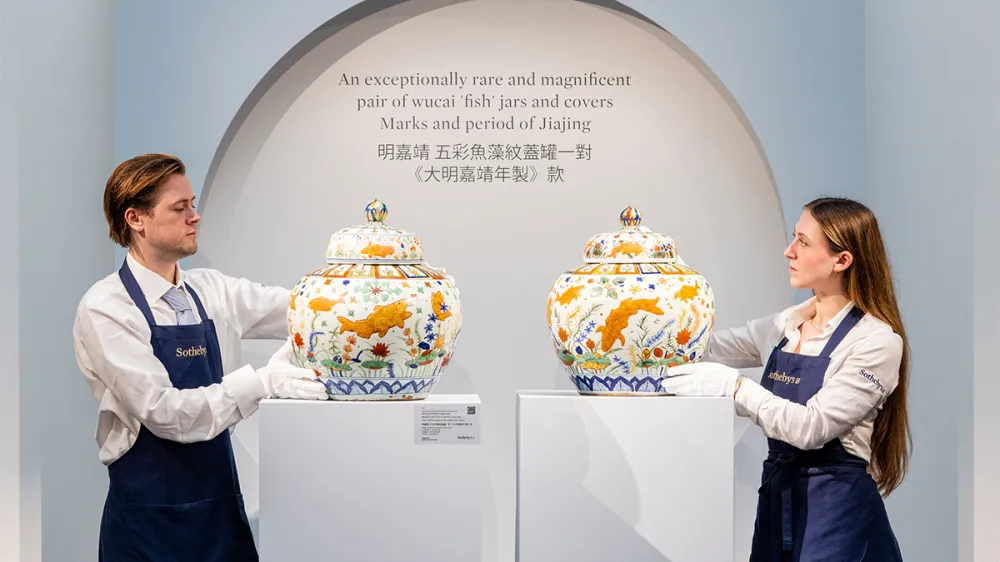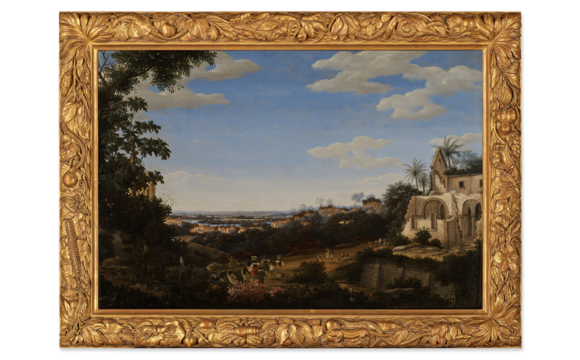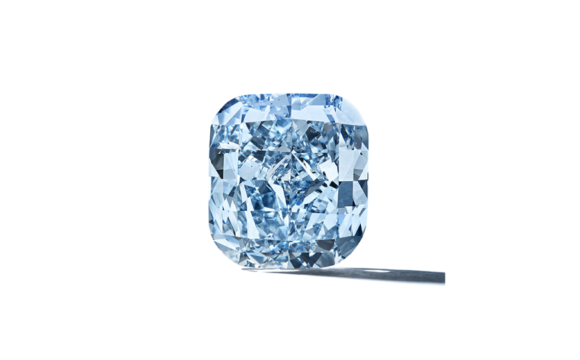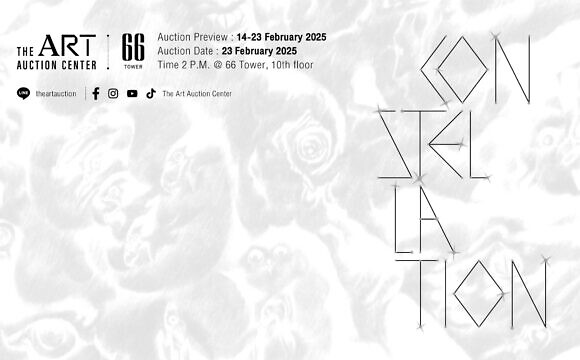เมื่อวันพุธที่ผ่านมา ณ ลอนดอน Sotheby’s ได้ขายคู่โถจีนสมัยราชวงศ์หมิงศตวรรษที่ 16 ที่ประดับด้วยปลาสีส้มในราคา 12.5 ล้านดอลลาร์ ซึ่งสูงกว่าราคาประเมินสูงสุดอยู่ที่ประมาณ 1 ล้านดอลลาร์
นักสะสมสิบคน ส่วนใหญ่แข่งขันกันทางโทรศัพท์ เข้าร่วมการประมูลโถคู่ ซึ่งปรากฏในการประมูลงานศิลปะจีน และในที่สุดก็ขายให้กับนักสะสมชาวเอเชีย
ผลลัพธ์ของการปรากฏตัวครั้งแรกในการประมูลของคู่โถปลาที่มีฝาครอบดังกล่าว ก็ทำสถิติเป็นงานศิลปะจีนที่มีราคาสูงที่สุดที่ขายในการประมูลทั่วโลกในปีนี้ด้วย
โถเซรามิกคู่ดังกล่าว เป็นส่วนหนึ่งของคอลเลกชันสะสมของครอบครัวชาวเยอรมันมานานกว่าศตวรรษ ก่อนที่จะถูกนำมาประมูลในวันนี้ มีเพียงตัวอย่างเดียวของโถคู่ที่มีฝาครอบที่คล้ายกันเท่านั้นที่ทราบว่ายังคงอยู่ และเก็บรักษาไว้ในพิพิธภัณฑ์ Guimet ในปารีส ยิ่งไปกว่านั้น มีเพียงสามโถที่อยู่ในการครอบครองของคนทั่วไปและเป็นที่ทราบว่ายังคงเก็บฝาครอบดั้งเดิมเอาไว้ด้วย
Henry Howard-Sneyd ประธานฝ่ายศิลปะเอเชีย ยุโรป และอเมริกาของ Sotheby’s กล่าวกับ ARTnews ว่า “ตั้งแต่แคตตาล็อกของเราได้รับการเผยแพร่ การตอบรับจากนักสะสมต่อคู่โถปลาอันล้ำค่านี้เป็นไปอย่างรวดเร็วและน่าตื่นเต้น" “การปรากฏตัวอีกครั้งหลังจากซ่อนตัวอยู่เป็นเวลาศตวรรษ เป็นโอกาสที่พลาดไม่ได้และไม่เหมือนใคร เนื่องจากปัจจัยความหายาก ความน่าตื่นเต้นนั้นถึงจุดสูงสุดในห้องประมูลวันนี้ และเป็นความตื่นเต้นสำหรับผมที่เป็นประธานในการประมูลและรับข้อเสนอราคาจากทั่วโลก"
“พวกเขาถูกย้ายไปยังที่ปลอดภัยพร้อมกับคอลเลกชันงานศิลปะของครอบครัวในช่วงสงครามโลกครั้งที่สอง ก่อนที่บ้านของครอบครัวในวิสบาเดินจะถูกทำลาย" บ้านกล่าว “ภาพถ่ายประกอบในนิตยสารศิลปะและการตกแต่งภายในของเยอรมันที่ตีพิมพ์ในปี 1926 แสดงให้เห็นคู่ของโถนี้โชว์ใน ‘ห้องผู้หญิง’; และโถคู่นี้สามารถพบเจอได้อีกครั้งในห้องนั่งเล่นของครอบครัวในบทความเกี่ยวกับวิลล่าหลังจากสร้างใหม่ ซึ่งมีอายุย้อนไปถึงต้นทศวรรษ 1950"
Sotheby’s ยังอธิบายอีกว่า “โถปลา" ที่ผลิตในช่วงรัชสมัยของจักรพรรดิ Jiajing (1522-66) ในจีนเป็นผลมาจาก “ความก้าวหน้าครั้งสำคัญในการผลิตเซรามิก เมื่อช่างฝีมือในเตาเผาจักรพรรดิบรรลุความสูงใหม่"
การขาย “ศิลปะจีน" มียอดรวม 19.6 ล้านดอลลาร์ เกินกว่าราคาประเมินสูงสุดที่ 9.3 ล้านดอลลาร์ โดยมากกว่า 55% ของล็อตเกินราคาประเมินสูงสุด
จากบทความโดย George Nelson for ArtNews
On Wednesday in London, Sotheby’s sold a pair of rare 16th-century Ming Dynasty Chinese jars decorated with orange fish for $12.5 million, blowing the house’s $1 million high estimate out of the water.
Ten collectors, most of whom competed by phone, were locked in a 20-minute bidding battle for the jars, which appeared in an auction of Chinese art. They eventually sold to a private Asian collector.
The result, which is the first ever auction appearance of a complete pair of such “fish jars" with covers, also marks the highest priced Chinese artwork sold at auction worldwide this year.
The porcelain jars were part of a German family collection for more than a century before going under the hammer today. Only one example of similar jars with covers is known to exist in a pair, and they’re held in the Musée Guimet in Paris. What’s more, only three other single jars in private hands are known to have kept their original covers.
“From the moment our catalogue was published, the response from collectors to this gem of a pair of ‘fish jars’ was swift and enthusiastic," Henry Howard-Sneyd, Sotheby’s chairman, Asian Art, Europe, and Americas, told ARTnews. “Their reappearance from view after being hidden for a century provided an unmissable—and unique—opportunity, given the rarity factor. That excitement culminated in a tremendous buzz in the saleroom today, and it was thrill for me to preside over the auction and field bids from around the world."
“They were removed to safety together with the family’s art collection during the Second World War, before the family home in Wiesbaden was destroyed," the house said. “A photograph illustrated in a German art and interiors magazine published in 1926 shows the pair on display in the ‘Ladies room’; the pair can be seen again in the family living room in an article on the villa after it was rebuilt, dating from the early 1950s."
Sotheby’s also explained that “fish jars" made during Jiajing Emperor’s reign (1522–66) in Imperial China were the result of a “major breakthrough in the possibilities of porcelain production, when the craftsmen in the Imperial kilns attained new heights."
The “Chinese Art" sale totaled $19.6 million, exceeding its high estimate of $9.3 million, with over 55 percent of lots surpassing their high estimates.
From the article by George Nelson for ArtNews








